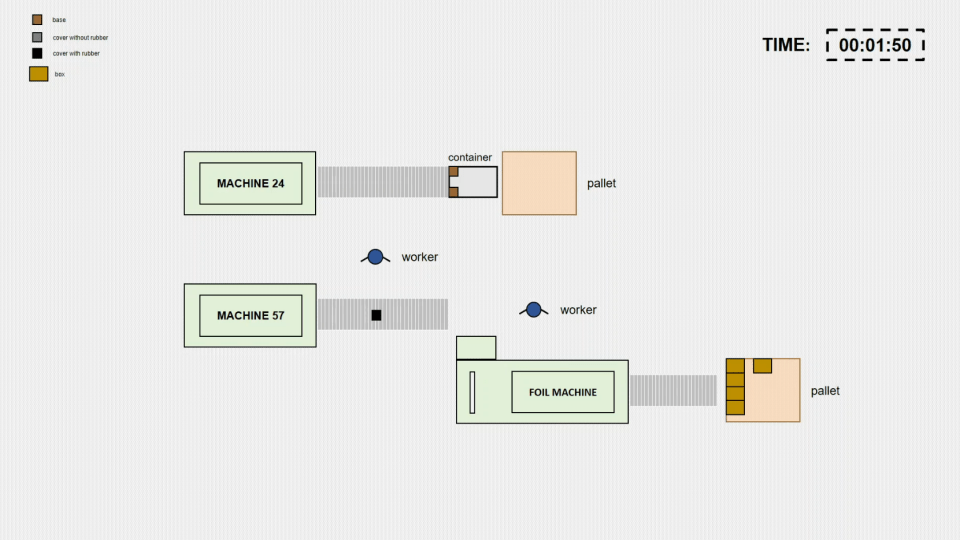This article covers assembly line process simulation and simulation-based line balancing. The simulation model is used for balancing lines and assembly processes.
I implemented this tool with software packages that do not cost any license fees. In other publications on this blog I already demonstrated other supply chain and factory simulation tools that I developed without having to invest in commercial simulation software licenses. Here are some examples:
- Link: End-to-end poultry supply chain simulation
- Link: Parking lot simulator with simmer in R
- Link: Simmer in R for discrete-event simulation
Costs for commercial simulation software licenses are significant. For smaller applications or project these costs cannot be justified. For processes, both factory-internal or supply chain wide, as well as therewith associated 2D animations, managers do however not have to rely on commercial tools. Instead, they can safely use free tools. This will merely require managers to hire analysts that can reliably use these tools.
Application scenarios and scopes
This simulation tool can be applied to manufacturing planning, especially line balancing and assembly cell design as well as assembly line design. The tool supports multi-line assembly process simulation. E.g. sub-assemblies and assembly parts can be manufactured at one cell and can then be assembled at down-stream assembly stations or on a in-line assembly station as part of another (main) assembly line.
Lines can have arbitrary amounts of manufacturing steps, and the processing times and batch sizes at each step can vary. Effective manufacturing takt time line balancing must be set by the modeller. This is the right approach anyways.
Manufacturing part and sub-assembly buffers between assembly stages are supported by the assembly line simulation tool. For example, you can have one assembly part being produced partly onto a temporary buffer if e.g. the main assembly line (consuming that part or subassembly) is operating at a slower (i.e. longer) cycle time. That buffer can then later be consumed by the main assembly line as soon as part production stops (following the speed of the main assembly line).
Technology stack for assembly line simulation
The assembly line simulator is a Python tool and developed as a Python framework that consumes existing Python frameworks for discrete-event simulation and animation. Most importantly, the framework developed consumes Tkinter and SimPy in Python. SQLite and MySQL databases can be integrated into the tool if desired by the user. For most applications this is however not necessary.
Exemplary assembly line simulation applications
Below is an animation that was generated by the tool and that visualizes throughput in an assembly process.
The upper manufacturing line operates at a higher throughput rate and shorter cycle time, operating nearly at twice the speed of the lower assembly line with integrated part manufacturing.
Machine 24 produces parts that are then inspected in-line. Parts are then automatically collected in a container that, once full, is stored on a pallet. The pallet acts as a buffer since part manufacturing on machine 24 operates at a (significantly) shorter cycle time than part manufacturing on machine 57.
Machine 57 produces base parts onto which parts produced by machine 24 are assembled. Some other smaller parts are assembled onto the base parts first, happening in line and without delaying the cycle time of machine 57. Parts used for assembly, manufactured at machine 24 are then assembled onto the base part. The assembly is then placed into the foil machine where it is foiled and subsequently packaged into boxes. These boxes are then stacked onto pallets and eventually shipped to the customer. When the buffer pallet at the end of machine line 24 is full, machine 24 is shut down and the parts buffered onto the pallet are now used for the assembly operation on the lower assembly line.
Related content
If you are interested in simulation and its application to supply chain management, network design and production planning you might find the following articles interesting:
- Link: Discrete-event simulation procedure model
- Link: Factory simulation: It’s all in the preparation
- Link: Crane yard simulation in AnyLogic
- Link: Manufacturing simulation for plant design
- Link: Open-cast mine simulation for better planning
- Link: A webshop for simulation developers

Data scientist focusing on simulation, optimization and modeling in R, SQL, VBA and Python





Leave a Reply